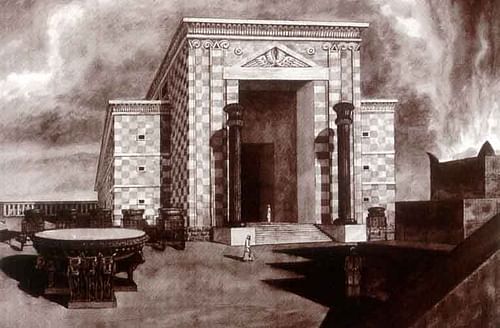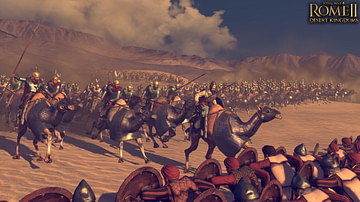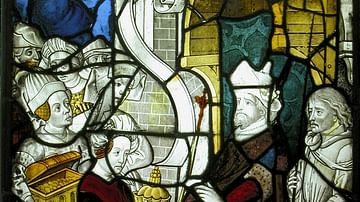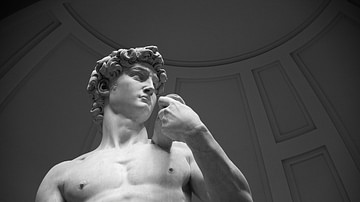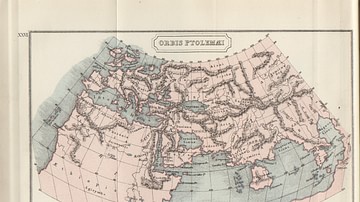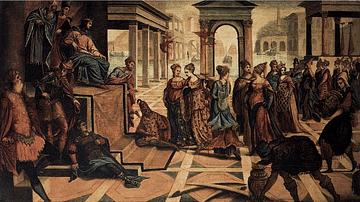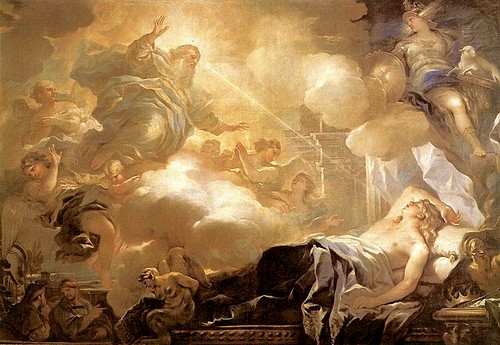
According to biblical tradition (and some say myth), King Solomon was the third and last king in the ancient United Kingdom of Israel. Other faiths, such as Islam and Rastafarianism, also embrace the notion of Solomon as a sagacious king and powerful prophet of Israel. He was renowned for his wisdom, his prolific writings, and his building accomplishments. Born around 1010 BCE, Solomon was the tenth son of King David (the second king of ancient united Israel) and the second son of Bathsheba. Like King Saul and King David, King Solomon reigned for 40 years in one of the highest and most prosperous periods in Israel's history - called by many, “The Golden Age” of Israel.
During his reign, Solomon controlled the trade routes coming out of Edom, Arabia, India, Africa, and Judea; he constructed an elaborate and profitable web of alliances (cemented by an enormous assemblage of hundreds of wives and concubines), and he purportedly built the first Temple of God in Jerusalem, which was destroyed (along with the entire city of Jerusalem) by the Babylonians in 586 BCE. Despite initial sovereign successes, the end of Solomon's rule was marked by several insurrections and attacks from both foreign and domestic enemies, as well as a disintegration of national and religious integrity because of cultural appeasements within Israel, which compromised and weakened the social fabric of the United Kingdom. He died in 931 BCE at age 80, possibly the most prosperous and productive king ever to rule over Israel.
The Traditional Story of King Solomon
The story of King Solomon begins with his father, King David, and his mother, Bathsheba. In the Hebrew scriptures, 2 Samuel 3 states that King David, anointed by the Prophet Samuel before King Saul's demise to be his replacement, officially became King of Judea (1010 BCE). Later, 2 Samuel 5 states that (in 1002 BCE) all the elders of Israel approached him to be their ruler, and “The king made a covenant with them at Hebron before the Lord, and they anointed David king over Israel.” King David's reign lasted 40 years, and like King Saul, it started off better than it ended.
David's initial zeal for God and for ethical integrity paved the way for his early fame and fortune, although being a man of warfare and blood (according to the scriptures), God decided that David was not suitable to be the one to build God's Temple (that would be placed in the hands of his son, Solomon). Moreover, David's illicit affair and subsequent devious actions (leading to the assassination of Uriah the Hittite and its cover-up) complicated the rest of David's reign - along with the rape of Tamar, the murder of Ammon, and the attempted coup of Absalom, among other controversies.
By the end of David's life, he had lost touch with Israelite society and eventually lost political control of it, as well. This led to an attempted coup by his son, Adonijah (whose mother was Haggith, David's fifth wife), who proclaimed himself to be king with the assistance of General Joab and Abiathar the Priest; however, the majority of Israel's institutional agents did not support Adonijah's claim. The Hebrew scriptures state that the Prophet Nathan went first to Bathsheba to alert her to Adonijah's usurpation of the throne, who then went to her husband, King David, to break the troubling news to him. Eventually, the Prophet Nathan joined the two, and King David officially made Solomon his heir apparent. David said, “Assuredly Solomon your son shall be king after me, and he shall sit on my throne in my place” (1 Kings 1).
Solomon Becomes King
King David died from natural causes in 961 BCE, was buried in Jerusalem, and, as suggested in the Hebrew and Greek scriptures, facilitated the establishment of the eternal kingdom of God through his piety and lineage. Before his death, David gave his final admonition to his son, Solomon, saying, “Keep the charge of the Lord your God: to walk in his ways, to keep his statutes, his commandments, his judgments, and his testimonies, as it is written in the Law of Moses, that you may prosper in all that you do and wherever you turn. . . for you are a wise man” (1 Kings 2).
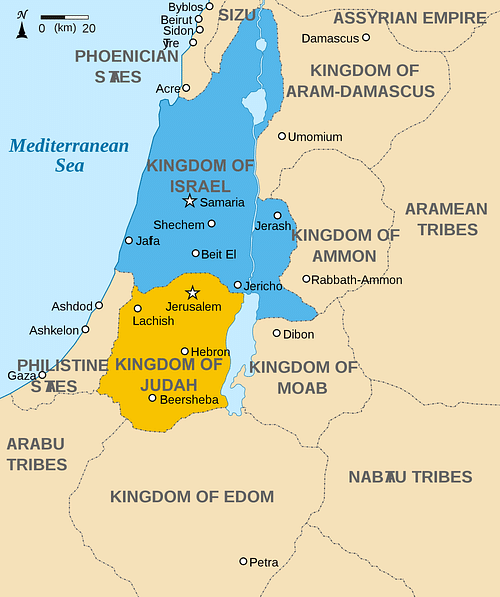
The threat of civil war and Adonijah's immediate execution as a traitor was averted for a time; however, Adonijah attempted to possess King David's former asexual concubine, Abishag the Shunammite, behind King Solomon's back. This enraged Solomon most likely because of Adonijah's surreptitious political triangulation of Bathsheba and because of Adonijah's political machinations to be following in King David's footsteps. Thereafter, “King Solomon sent by the hand of Benaiah the son of Jehoiada' and he struck [Adonijah] down, and he died” (1Kings 1). King Solomon also dispatched the other ringleaders of the coup - General Joab and Abiathar the Priest, although Joab was executed and Abiathar was exiled.
Perhaps one of the more fantastical yet pivotal parts of the biblical story of Solomon is the divine gift that he received from God as recorded in the Hebrew scriptures. Solomon implored, “Now, O Lord God, let your promise to David my father be established, for you have made me king over a people like the dust of the earth in multitude. Now give me wisdom and knowledge.” According to the Hebrew scriptures, this impressed God, so Solomon received not only knowledge and wisdom, but also “riches and wealth and honor, such as none of the kings have had who were before you, nor shall any after you have the like” (2 Chronicles 1). The Qur'an also indicates that Solomon received a divine gift of wisdom, along with other special gifts (21:78–79) - "And We made Sulaiman [Solomon] to understand (the case); and unto each of them We gave judgment and knowledge."
Features of Solomon's Reign
Solomon's prosperity and success were also achieved through ingenious reforms and innovations such as the improvement of defense measures; the expansion of the royal court; the financial windfall from more sophisticated taxation, labor conscriptions of Canaanites and Israelites, tributes and gifts from foreign countries under the influence of Solomon; and a land and sea trading system that utilized a powerful navy and army to protect assets and trade routes. According to the Hebrew scriptures, “The king made silver and gold as common in Jerusalem as stones, and he made cedars as abundant as the sycamores, which are in the lowland” (2 Chronicles 1).
King Solomon was also famous for his international relationships, forming alliances with other nearby powerful nations such as Egypt, Moab, Tyre, Arabia, etc. Many of these partnerships were cemented through royal marriages and the giving of concubines to Solomon, eventually gaining him 700 wives and 300 concubines. One of King Solomon's more famous political-amorous relationships was with the Queen of Sheba (which some speculate to be modern-day Yemen), who visited Israel with a lavish tribute of 120 talents of gold. The Hebrew scriptures state, “And when the queen of Sheba had seen the wisdom of Solomon, the house that he had built, the food on his table, the seating of his servants, the service of his waiters and their apparel, his cupbearers and their apparel, and his entryway by which he went up to the house of the Lord, there was no more spirit in her” (2 Chronicles 9).
Clearly, the Queen was impressed with Solomon and his accomplishments, and the two cultivated an intimate relationship, with Sheba helping create, foster, and maintain Solomon's trading with other Arabian kings. Additionally, according to the Rastafarian faith, Solomon and Sheba conceived a child together, whose descendants included Haile Selassie I, "the God of the Black race," as Selassie would then be related to both King David and Jesus Christ of Nazareth.
Solomon's Temple
King Solomon is credited in the Hebrew scriptures as sponsoring, planning, funding, and executing the building of the Temple to house the Ark of the Covenant, per the wishes of his father, King David, and God. The building of the Temple is recorded in 1 Kings and 2 Chronicles, with the ground-breaking beginning in the fourth year of Solomon's reign, and construction was completed seven years later with an ostentatious dedication. In a seven-day celebration, Solomon sacrificed 22,000 oxen and 120,000 sheep to celebrate the Temple's completion and God's willingness to dwell among them, therein.
The architectural design of the Temple was modeled after the tabernacle that had housed the Ark of the Covenant for decades (if not centuries). Quite lavish, it was double the size and built mainly from stone, with cedar paneling to hide all masonry, which was overlaid with gold. The inside of the Temple was decorated with elaborate carvings (gourds and open flowers), golden lampstands, an altar of incense (also called “the golden altar”), and two bronze pillars among other embellishments. In a less-advanced architectural age, at over 100 feet long by 40 feet wide by 60 feet high (30 x 12 x 18 m) with outer doors of ivory, the First Temple must have seemed an impossibility, a miraculous achievement, for most visiting Israelites.
According to the Hebrew scriptures, after the Temple was completed, Solomon had the Ark of the Covenant finally moved from the tent that King David had made for it and placed it in its specialized chamber on the most western end of the Temple called, “The Holy of Holies.” A perfect 20 x 20 x 20 ft. (6 x 6 x 6 m) cube, this was the most sacred room that no one besides the Chief Priest could enter (on the Day of Atonement) without dying. Institutionally and nationally, it was the intersection of the Divine with his People through his mediator. The Temple did not just house the Levitical priests of God. Side rooms and a courtyard were constructed around the whole building, with areas sectioned off for both the priests and the common people of Israel.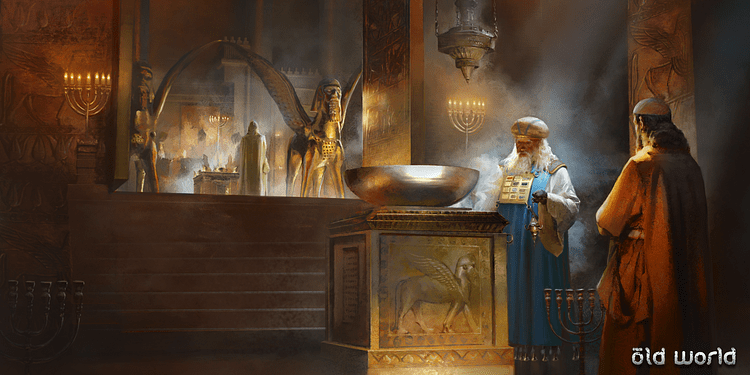
Solomon's Literature
King Solomon is also credited for contributing several books and literary works to the Hebrew scriptures including the Book of Proverbs, the Song of Songs, and Ecclesiastes, as well as traditionally penning some extra-biblical works including musical songs, poetry, histories, and scientific works in botany and zoology (although no extant writings have been discovered, currently). Under Solomon, Israel's golden age produced most of the works that were eventually gathered together into the “The Writings” or “Kethubim” section of the Hebrew scriptures.
Although theology is a component of Solomon's writings, the wisdom genre (also seen in Egyptian and Akkadian literature) focuses more on areas outside of theology - providing advice on the created world, relationships, practical matters, and assorted personal topics or challenges. Thus, Proverbs deals with the art of living, with how to make intelligent choices for one's future well-being. The Song of Songs (or Song of Solomon) is a romantic poem that presents the ultimate union between the bride and the bridegroom, focusing on themes of love, wisdom, beauty, power, desire, sex, loyalty, etc. The Book of Ecclesiastes is a royal testament that includes personal reflections, meditations, and instructions on the meaning and purposes of life, alluding to several aspects that would have been relevant to Solomon's own personal experiences - wisdom, futility, riches, servants, hedonism, productivity, and humble self-realization. Although Solomon was the original sage for many of his proverbs, he also searched his kingdom and empire for other writings and ideas of erudite men and included them in his compilations.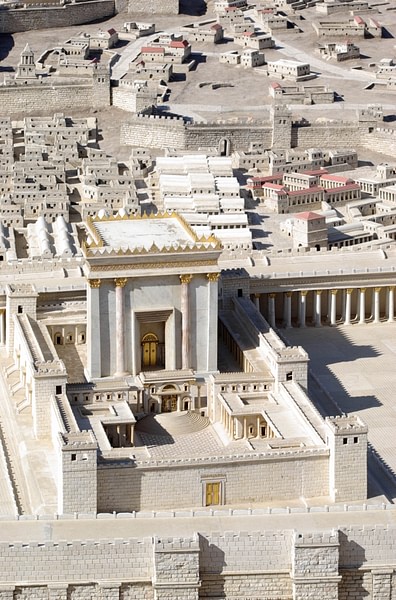
Losing Favour With God
Despite all these great accomplishments, the Hebrew scriptures indicate that the decline of Solomon was similar to the fall of the previous kings of United Israel - similar, in that personal vanity and religious/moral compromise led to social disintegration and strife. Solomon slowly deprioritized his relationship and obligations to God in order to appease his many foreign wives and in order to protect the prosperity and longevity of his rule. Ultimately, “[Solomon's] wives turned his heart after other gods, and his heart was not fully devoted to the Lord his God, as the heart of David his father had been” (1 Kings 11). Solomon's ungrateful, disloyal actions and attitude - despite being the wisest and most blessed man on the earth - provoked the anger and judgment of the Lord.
Thus, although still able to keep control of the nation of Israel because of God's promise to King David, Solomon lost the protection and favor of God that earlier had provided remarkable peace and prosperity when he was obedient to God. Solomon soon found new challenges from within and without his kingdom, including Jeroboam who was promised to reign over Israel by the Prophet Ahijah, from Hadad of Edom who challenged Solomon's territorial control in the southern territory of Israel, and from Rezon of Damascus, who threatened Solomon's control over the northern territory of Israel.
King Solomon died of natural causes in 931 BCE at the age of 80. His son, Rehoboam, inherited the throne, which led to a civil war and the end of the United Kingdom of Israel in in 930 BCE.
Epigraphical & Archaeological Evidence for King Solomon
As with King David, verifying the existence of King Solomon is challenging, at best, especially since epigraphs typically provide imprecise information, and the biblical accounts rest upon a presupposition of supernatural realities. Although there is much archaeological and epigraphical evidence to substantiate the possibility of some/many (non-supernatural) scriptural assertions, archaeological finds to date have provided mostly indirect affirmation. With such huge gaps in archaeological evidence and with the contamination of too many archaeological fields, it is easy to speculate, theorize, or make an argument from silence, but it is difficult to empirically prove or disprove the existence of Solomon. Still, some provocative-yet-controversial archaeological finds have been recently unearthed over the last century that require consideration.
Although its first discoverer is unknown, in 1828 CE, Jean–François Champollion, who also discovered the Rosetta Stone in 1799 CE, examined the Bubastite Portal gate (built in 925 BCE) at the temple of Amun in Thebes. On its walls, among the historical paintings, a long list of defeated peoples by Pharaoh Shoshenq is accessible, including those from the “Highland/Heights of David,” presumably led by King Rehoboam, which led Champollion to conclude that Pharaoh Shoshenq and King Shishak of Egypt, as referenced in 1 Kings in the Hebrew scriptures, are one and the same.
In 1868 CE, Missionary Frederick Augustus Klein discovered an intact stele in Dhiban, Jordan, called the “Mesha Stele” or the “Moabite Stone,” with text that he could not read. Although the stele was smashed by contentious locals the next year, a papier-måché impression had been made of it and the stele was reassembled. The inscription on the stele references the Moabites, their god, and also references the nation of Israel and Omri, her sixth king. Similar finds such as the Black Obelisk of Shalmaneser III and the Chronicle of Sennacherib also confirm the existence of Israelite kings during the Assyrian hegemony.
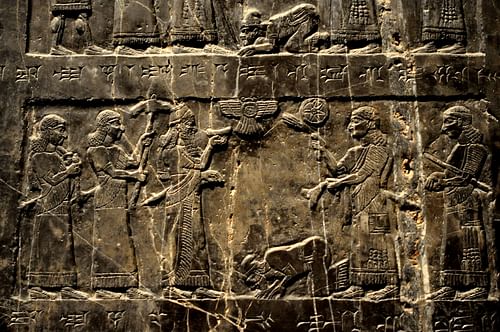
Between 1957 CE and 1971 CE, archaeologist Yigael Yadin began excavations at two of the three cities mentioned in 1 Kings 9 (fully at Hazor and in a cursory investigation at Megiddo), which had gates supposedly built by King Solomon c. 960 BCE. Based on compared archaeological evidence from all three sites, which included Macalister's excavation report at Gezer from 1902–09 CE, Yadin concluded that the three city gates were designed by the same engineer (based on the same structural dimensions), built by the same workers (stylistically and methodologically from Phoenicia), and utilized the same material (they contained ashlar masonry quarried in Tyre). Additionally, in the 1860s CE, Charles Warren discovered a wall and courtyard in Jerusalem that were later found to be identical to the one in Megiddo and dating from the period of King Solomon.
In 1993 CE, Avraham Biran discovered the Tel Dan Inscription on a broken stele in northern Israel. The inscription commemorates the victory of an Aramean king over its southern neighbors, and specifically references both the “king of Israel,” and the “king of the House of David.” This is perhaps the first real, direct, historical evidence for the Davidic Dynasty in Israel.
In 2010 CE, Eilat Mazar and her team discovered a 10th century BCE wall between the Temple Mount and the modern-day Arab neighborhood of Silwan. The wall was part of a larger complex that included a gatehouse, guard tower, and other buildings. Based on artifacts found in and around the area, Mazar suspects that the wall is at least 3,000 years old, which would place its construction in the time period of King Solomon (as referenced in 1 Kings).
In 2012 CE, Eilat Mazar and her archaeological team discovered an ancient structure at the Ophel in Jerusalem that dated back to the Solomonic era. In a bedrock depression within that structure, the archaeologists also discovered a large storage jar (or pithos) with the earliest alphabetical letters ever found in Jerusalem written on an earthenware jug. Although the seals do not directly reference King David or King Solomon, the Ophel Inscription not only suggests an advanced society living in Jerusalem earlier than previously believed; it also indicates a fully-functioning administration that collected taxes and implemented regulations during the period of King Solomon's reign.
In 2013 CE, Erez Ben-Yosef and his archaeological team discovered radiocarbon dating evidence forcing many archaeologists and historians to revise their presumptions about the copper mines in Israel's Aravah Desert. Previously assumed to be Egyptian, the new evidence suggests that the mines were actually operated by the Edomites, the ancient enemies of Israel repeatedly referenced in the Hebrew scriptures, who lived during the period of Solomon.
In 2014 CE, students and faculty from Mississippi State University discovered six official clay seals in southern Israel near Gaza. Although the seals do not directly reference King David or King Solomon, the Khirbet Summeily clay seals indicate official government activity in 10th century BCE, which had been assumed to be too tribal for such sophistication.
In 2016 CE, Israeli archaeologists discovered numerous small artifacts from the Temple Mount, which have been dated to the time of the First Temple, nearly 3,000 years ago. Shards from the archaeological dig include pottery fragments (a standard in general archaeological dating), olive pits, animal bones, and they all share a uniform date from the Solomonic period, according to the team's findings.
Conclusion
By no means conclusive, the aforementioned discoveries do give some credence to the theory that a United Kingdom of Israel once existed in the Mediterranean region although Israel's regional influence, military prowess, infrastructural contributions, and early pivotal leaders are still somewhat veiled. Fortunately, new archaeological discoveries continue to be made and advanced technology continues to bring to light the shadows of that which has been hidden for centuries and centuries.
Archaeological and historical evidence of other kings of Israel and Judah - such as Omri, Ahab, Joram, Ahaziah, Jehu, Hezekiah - have been uncovered in the historical landscape (and one could conceivably expect more to follow). Still, considering the traditional view of King Solomon as the wisest, most prosperous man on earth and King of his time (and of all future kings of Israel), the lack of direct historical and archaeological references to him, to the name “King Solomon” outside of the Hebrew scriptures, which portray him as the wisest of all fools, is quite ironical or evidential, indeed.
